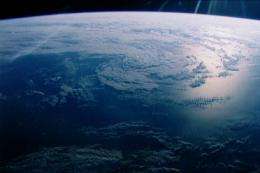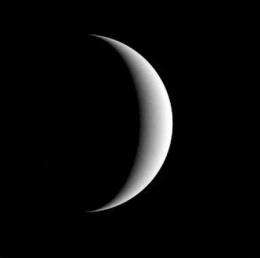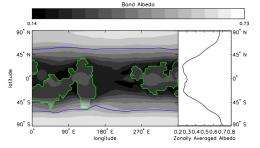Can astronomers detect exoplanet oceans?

Detecting water on the surface of exoplanets is becoming a high priority for researchers, as surface water is considered a requirement for habitability. New research examines whether or not the "glint" of light from a planet can be interpreted as evidence for surface oceans.
Given the plethora of confirmed exoplanets, many researchers have turned their attention to studying these strange new worlds in greater detail. With several exoplanets thought to orbit in the “habitable zone” of their host star where liquid water might be stable, different methods of detecting surface water are under development. One such proposed method of detecting water oceans on an exoplanet is via specular reflection, also known as “glint”. If you've seen a bright reflection of sunlight on a lake or ocean here on Earth, you've seen an example of the glint effect.
Scientists posit that surface oceans of exoplanets would affect the planet’s apparent reflectivity, also known as albedo. This increase of albedo should be detectable during the crescent phase of a planet.
In this model, astronomers don’t need to see the entire “disk” of a planet, where the planet is reflecting light like a full Moon from our point of view. Instead, they can detect reflected starlight in a planet’s gibbous phase, where we see only a part of the entire “full Moon” light. It is even possible to view an exoplanet in a crescent phase, where just a small sliver of reflected light is visible.
A Glint in the Eye
A team of scientists led by Nicolas Cowan of Northwestern University is examining the “glint” model for detecting exoplanets. Cowan and his team used a model of an Earth-like planet to simulate reflected light curves.
Cowan stresses the importance of a reliable method to detect oceans on exoplanets, stating: “Astronomers are keen to figure out how to detect oceans on exoplanets, because biologists assure us that liquid water is necessary for life as we know it. The challenge is that exoplanets are very far away, so at best they appear as Carl Sagan's proverbial ‘pale blue dot’.“

Despite their model not including specular reflection, the team was able to obtain glint-like variations. Planets that have a modest tilt (or obliquity) receive less light at their poles than at their equator. The lower light levels would result in colder temperatures, alowing snow and ice to accumulate at the poles.
The team shows that at crescent phases, a modestly-tilted planet appears to reflect more light from higher latitudes (such as the poles) than when the planet is in a gibbous phase. Because snow and ice are so reflective, the apparent reflectivity of a planet will seem to increase if a planet is observed in a crescent phase. Cowan and his team assert that this “latitude-albedo effect” can be mistaken for the glint of oceans on exoplanets.
“The crux is that the light we see from a planet at crescent phase is hitting the planet at a glancing angle,” adds Cohen. “What kinds of places receive glancing sunlight? You might be catching a region right at dusk or dawn, but more likely you are seeing a cold place, since glancing sunlight is precisely what makes a place cold. Low temperatures mean the surface is more likely to be covered in snow and ice. Since snow and ice are very reflective, the net effect is that the planet looks abnormally bright at crescent phases, regardless of whether it has oceans.”
Seeking ExoOceans
In their paper, the team outlines three possible methods to detect surface liquid on an exoplanet. The first method, “rotational color variability,” is based on the fact that oceans are darker and have different colors than other surface types on Earth. Over time, the variations in color of a spatially unresolved planet can betray the presence of liquid water oceans.

The second method relies on the alignment of the light waves being reflected (polarization). Oceans are smoother than other surface types and can align the light waves reflecting from the water's surface, thus polarizing the reflected light. Observations of polarized Earthshine suggest that variations in polarization may help astronomers detect oceans.
Lastly, specular reflection states that oceans are able to reflect light in a manner similar to a mirror, especially at crescent phases.
“Water can do this because it is much smoother than land, trees or snow,” says Cowen. “Even though the glint spot is small, it makes a planet look abnormally bright at crescent phase. Therefore, if you could keep track of a planet's brightness as it orbits its host star, you might be able to infer the presence of a glinting ocean.”
The team noted previous research which showed that clouds and scattering of reflected light can mimic a glint signal at crescent phases. The team also noted that any method used to detect surface oceans on a planet would be hindered by atmospheric clouds. The three techniques previously listed have been shown to work with a high degree of confidence on Earth-Like planets with roughly 50% cloud cover.
In the team's letter, accepted for publication in the Astrophysical Journal (ApJ), the focus is on the specular reflection method. The research shows a tendency for planets in the habitable zone of their host star to have snow and ice in the regions least illuminated by sunlight, which naturally leads to a false positive for ocean glint, regardless of axial tilt.

Given the results of the simulations, Cowan and his team state that the latitude-albedo effect presents an interesting challenge to the detection of specular reflection (glint). The team asserts that in order to confirm a signal as an actual detection of liquid water, the albedo needs to increase at crescent phases, and be symmetrical at the waxing and waning phases.
In addition to the concerns with albedo increases, the team states one other critical variable is the planet’s axial tilt, or obliquity – how far a planets “north” pole is tipped towards or away from observers on Earth.
Furthermore, based on the team’s results, if no snow or ice is present on a planet, or if the surface is obscured by thick cloud cover, the latitude-albedo effect is thought to still apply if the coldest regions of the planet are mostly cloudy. The team stresses the previous scenario is present in their simulation, but may not be the case in general since the planet’s position within the habitable zone may play a role in atmospheric conditions and surface temperatures.
Detecting ocean glint on Earth-like exoplanets may only be possible if the effects of clouds, snow and ice can be properly modeled. The team notes that “high contrast” imaging missions should be able to monitor the apparent albedo of rocky planets orbiting in the habitable zone of their parent star.
Based on the results of their simulations, the team asserts the latitude-albedo effect will limit attempts to interpret reflected light from terrestrial planets in the habitable zone of M-class dwarf stars.
More information: “A false positive for ocean glint on exoplanets: The latitude-abedo effect.” arxiv.org/pdf/1205.1058v1.pdf
Journal information: Astrophysical Journal
Source: Astrobio.net





















